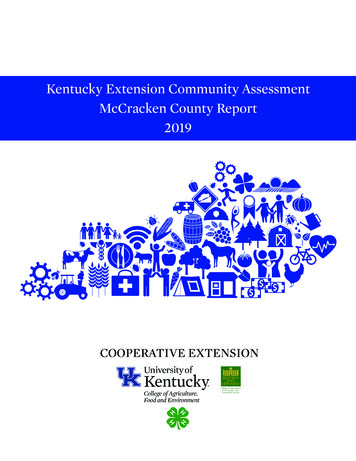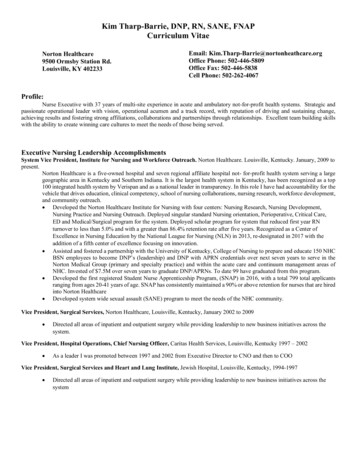
Transcription
Kentucky Extension Community AssessmentMcCracken County Report2019
University of KentuckyCollege of Agriculture, Food and EnvironmentCooperative Extension ServiceDear Community Member,Thank you for your support and participation in the Kentucky CooperativeExtension Service Community Needs Assessment. The purpose of this assessmentis to better serve you through targeted educational programming.The Kentucky Cooperative Extension Service is the outreach arm of the Universityof Kentucky College of Agriculture, Food and Environment and Kentucky StateUniversity College of Agriculture, Communities and Environment. With offices inall 120 counties of the Commonwealth, Extension provides practical, research-basededucational programs and information.Extension values community input into educational program development andhas from its inception more than a century ago. Every four years, each Extensionoffice prepares a plan of work that includes gathering information from communitymembers as well as secondary data to inform the plan.Our state is changing, and new areas of need are emerging. To standardize our planof work process, a committee of Extension personnel and community membersdeveloped the community needs assessment process to formalize that datagathering portion.We expected a large response and we were not disappointed. Over 38,000 peoplecompleted the survey. More than 500 interviews and focus groups were conducted.We will use this information to develop local plans of work in our counties aswell as regional and statewide initiatives to make a positive impact in the lives ofKentuckians.We look forward to continuing to serve you.Sincerely,University of Kentucky Cooperative Extension Service AdministrationS 107 Ag Science North Lexington, KY 40506 P: 859-257-1803 extension.ca.uky.eduMcCracken County Extension Assessment 20193
ASSESSMENT OVERVIEWIn the fall of 2018, the University of Kentucky Cooperative Extension Service began a statewide assessmentof community issues and priorities from across the Commonwealth. County Extension offices led the effortby collecting feedback from various county residents, stakeholders, and organizations. Each county collectedfeedback through surveys, focus groups, and interviews with community stakeholders. The goal of this projectwas to gain a better understanding of the needs and priorities facing communities in Kentucky. Gatheringinformation from each county allowed both a broad view of state community issues and an opportunity todetail and address issues specific to counties. Utilizing the results, the University of Kentucky and CooperativeExtension Service can align resources and improve services and partnerships in response to the priority needsof each county. This report is a summary of the data collected in this county.Community SurveyA community needs assessment survey was developed by a committee representing a mix of county ExtensionAgents, Extension Specialists from departments across the University of Kentucky, and community stakeholders.The assessment survey was shared with each county Extension office. In turn, Extension Agents invited countyresidents to participate in the community needs assessment survey. The survey was electronically distributed bysocial media and email, and was distributed on paper to individuals, groups and organizations to be completed.Focus GroupsCounty Extension office staff convened community members in interactive focus groups in the fall of 2018. Thefocus group listening sessions were designed to allow community members to discuss their ideas on the futureof the county in more detail than allowed on the survey. Participants in the focus groups were invited to discusstheir vision for a more vibrant county, issues for the future, barriers to issue resolution, resources or informationthat would help the issues, and ideas for an improved future. A summarized reporting of the results of theselistening sessions are included in this report.InterviewsIn addition to the survey and focus group sessions, county Extension Agents also conducted interviews withindividuals in formal leadership roles in the county. The interview questioning followed a similar formatto the focus groups, seeking information on pressing needs, long term needs, and exploring the role thatExtension might serve to address future issues confronting the county.Secondary DataTo complement the survey, focus groups, and interviews, detailed data profiles have been compiled for eachcounty that correspond to topic areas covered in the survey. This information provides additional context tounderstand the role of identified issues in each county as well as historical data to highlight trends.Next StepsThis report summarizes the information collected for this county. The report and the included secondary datacompilation can serve as a starting point for deeper investigation into the issues of concern and priority forcommunity members. The University of Kentucky and Cooperative Extension Service will support the countyin addressing the priorities identified through this assessment.McCracken County Extension Assessment 20194
SURVEY RESPONDENTS468 Respondentsare Femalehigher thanCounty populationare White(non-Hispanic)same asCounty populationwork or areself-employedare retiredcurrentlyparticipatein ExtensionprogrammingMcCracken County Extension Assessment 2019are 25-64 years old(working age)higher thanCounty populationwork in non-profit,transportation, ormanufacturingrespondent familiaritywith Extension5
SURVEY RESULTSISSUE IMPORTANCE468 respondents ranked 62 community issues on a scale of “very important” to “not important.”The table below lists all 62 community issues. The numerical value listed next to each issue represents theaverage rating across all respondents. Below is the scale used to determine the average rating:Very important 4Important 3Not that important 2Not important 1The table is organized into two columns, and the issues have been sorted with the most important issue(on average) listed at the top of the left column.Category Legend: Health & Wellness3.933.883.853.84 Youth & Families Agriculture & Environment More jobs paying good wages with benefits3.76 Improved affordability of health care insurance Fewer overweight or obese youth and adults Fewer chronic diseases (diabetes, heart disease, cancer, etc.)Improved access to quality, affordable health care providers (medical, dental, etc.)More youth life skills training (money management, life decision making, etc.) More affordable, quality elder care options Trustworthy and effective law enforcementBetter family skills in reducing debt, increasing savings and financial planning3.75 More support for families with mental and emotional health issues3.753.73 More qualified leaders to prepare community for the future Affordable quality child care3.733.733.713.70 3.693.693.683.683.68 Improved availability of health care insurance More support for prevention of school violence and bullying Better roads and bridges More citizens helping to solve local issues More support for families and individuals with special needs3.683.663.663.653.653.65 3.813.793.783.763.653.653.653.63Responsive emergency servicesLess illegal dumping and litteringBetter youth and adult career readinessMore senior citizen support programsStronger parenting and relationship building skillsMore pride in the community and its assetsMore effective cooperation between community organizationsImproved sustainability of family farmsIncreased support for small businessSafe and accessible public water and sewerBetter use of food safety practices (hand washing, storage, preservation, etc.) More support for relatives raising children of family members More sources for buying safe, affordable, fresh food Safer use of prescription medicationsMcCracken County Extension Assessment 2019 Jobs & Infrastructure Community Vitality3.62 Availability of substance use treatment3.62 More child and partner abuse prevention resources3.61 More active community volunteers3.60 More youth community leadership opportunitiesMore sources for buying safe, affordable, fresh local3.59 foods3.58 Safer community places to walk, run, bike, etc.3.58 More market opportunities for farmers3.58 Availability of substance use prevention programs3.58 Improved sidewalks and crosswalksMore support for Kentucky agriculture and3.58 agribusinessesMore qualified employees for either existing and new3.57 jobs3.57 Access to affordable, reliable high speed internet serviceMore community marketing efforts (tourism, industry3.56 attraction, etc.)3.55 More individual physical activity opportunities3.53 More profitable farms3.52 Better skills for selecting and preparing healthier foodMore healthy snacks and food options at restaurants and3.51 community events3.46 Better utilities (water, sewer, etc) to attract industry3.45 More crop and livestock production opportunities3.45 Less pest, disease and weed issues3.43 More public transportation optionsBetter employee "soft skills" training (communications,3.41 team work, etc.)3.39 More community gardens3.39 More training for food gardening skills3.37 More community parks and green spaces3.37 More land available for food production3.34 Increased tree and forestry management3.293.283.243.20 More farm related jobsMore tourism-related businessesMore part-time and summer job opportunitiesBetter landscapes for improved home value6
SURVEY RESULTSTOP PRIORITY ISSUESAfter respondents ranked the importance of issues in their community, they were asked to identify the top threepriorities for their community in each issue category.299 respondents chose issues by priority, and the resulting top three priorities for each issue category are listedbelow.By prioritizing the issues, respondents are not just identifying how important each issue is for their community,but rather which issues they would prioritize in their community.Jobs & Infrastructure1. More jobs paying good wages with benefits2. Increased support for small business3. Trustworthy and effective law enforcementAgriculture & Environment1. Less illegal dumping and littering2. Improved sustainability of family farms3. More market opportunities for farmersHealth & Wellness1. Improved affordability of health care insurance2. Fewer chronic diseases (diabetes, heart disease, cancer)3. Improved access to quality, affordable health care providersYouth & Families1. More youth life skills training (money management, life decision making)2. More support for prevention of school violence and bullying3. Better family skills in reducing debt, increasing savings and financial planningCommunity Vitality1. More qualified leaders to prepare community for the future2. More citizens helping to solve local issues3. More community marketing efforts (tourism, industry attraction)McCracken County Extension Assessment 20197
FOCUS GROUP FEEDBACKThe McCracken County Extension Office staff convened 32 community members in three interactive focus groups.These focus group listening sessions were designed to allow community members to discuss their ideas on the futureof the county. The attendees were invited to discuss their vision for a more vibrant county, issues for the future,barriers to issue resolution, resources or information that would help the issues, and ideas for an improved future.Vison for a More Vibrant CommunityThe focus group participants had many ideas for the future of the county. Many of the ideas related to opportunitiesthat would enhance entertainment and tourism including:Paintball, zip lines, sky diving, horseback trails, running and mountain biking trails, water parks, pool and recreationcenter, new baseball complex, museums, and increased opportunities for youth.Identified Priorities Increase tourism Increase minimum wage Better interaction of city/county government Improved high speed internet Address drug issuesPriorities DiscussionThe immediate public priorities included: Fix roadways- including sidewalks, street lights, bus stops and benches Address drug issues – including more access to rehab, drug education and intervention programs, and havebetter community interaction with law enforcement Address low paying jobs and employment opportunities Improve housingOver the next four years, focus group participants would like to see: Increase tourism opportunities – including a baseball park, museums, water park, and things for kids to do Improve intergovernmental relations so that County and City government officials work together to solvecommunity issues Increase community involvementMcCracken County Extension Assessment 20198
STAKEHOLDER INTERVIEWSSix interviews were conducted with people in positions of leadership in McCracken County. The interviews followeda similar format to the focus groups, seeking information on pressing needs, long-term needs, and exploring waysthat Extension might serve to address issues confronting the county. The interview perspectives are compiled andsummarized to represent key discussion ideas.Identified Priorities Livable wage jobs (3) Quality and affordable housing (2) School safety (2) Drug issues affecting employment Community walkabilityPriorities DiscussionInterviews with positional leaders in McCracken County surfaced the complexity of addressing public issues. Whilethey are immediate priorities, there are no quick fix solutions for many of the issues McCracken and other Kentuckycounties are experiencing. Issues raised in the interviews include: Dealing with poverty School safety Racial tension Affordable/quality housing Livable wage employment opportunities Population decline in the city The public pension crisis Public walkability for communitiesWhen asked about 4-year priorities, the interviewed leaders expressed the importance of working on the immediatewhile looking to longer term goals. Priorities identified to be addressed over the next four years included: Increase competitive jobs and job retention for local youth (3) Increase opportunities for growth of industry (2) Expand jobs skill/workforce education (2) Improve services and activities for youth & children Expand opportunities for trade workers Expand transportation options including airports Expand city limits Expand pension plan Address storm water issues Renovation of homes and rental propertyMcCracken County Extension Assessment 20199
SECONDARY DATA PROFILEUNDERSTANDING YOUR SECONDARY DATA PROFILEAs part of the Community Assessment process, each county is provided with a profile of secondary data. Thegoal is to supplement the survey, focus groups and interviews with a wide range of secondary data. The dataselected for the profiles correspond to the topics covered in the survey and a list of variables provided by thecommittee that designed the assessment process.As counties begin to understand the results from their surveys, focus groups and interviews, these data providean additional dimension to understanding the role of particular issues in each county.Profile DataData in each profile are organized as follows: countydemographics; families and households; agriculture; jobs,economy and labor force; youth; and health and wellness.Because we all relate to data in different ways, within eachsection, the data are presented using three different formats:County DemographicsFamilies and HouseholdsAgriculture Tabular data NarrativeJobs, Economy andLabor Force GraphicYouthComparison data over time or comparisons with the state asa whole are provided where space allowed.Health and WellnessFinding More DataIf you need additional data, many sources are available. On the back page of each profile, we provide informationfor each of the data sources we used. We also provide a list of websites where you may access them.For easy access to a wide array of data, visit Kentucky: By The Numbers, the Building Strong Families Profilesfrom Family and Consumer Sciences Extension, and the County Data Profiles from the Community andEconomic Development Initiative of Kentucky (CEDIK).If you need help in finding more data or if you need assistance in understanding this secondary data profile,please feel free to contact Dr. Julie N. Zimmerman (jzimm@uky.edu) in the Department of Community andLeadership Development.McCracken County Extension Assessment 201910
McCracken CountyData ProfileKentuckyBy The NumbersMcCracken County’s Data Profile is provided by the Kentucky: By The Numbers program in the Department ofCommunity and Leadership Development for the Community Assessments conducted by the University of Kentucky’sCooperative Extension Service. These secondary data profiles supplement the survey, focus groups, and key informantinterviews conducted in each county across the state through the County Extension Offices and coordinated by Communityand Economic Development Initiative of Kentucky (CEDIK).The overall goals for the Community Assessments are: To gain a better understanding of the county’s pressing issues; To enhance Extension’s place-based approach by providing information on locally relevant issues in counties; To gain a better understanding of how Extension can support important community change to improve Kentucky; To provide a statewide view of how top issues are distributed across the state.For more information on the Community Assessment process, visit r additional data or other data-related assistance, contact: Dr. Julie N. Zimmerman (jzimm@uky.edu)County DemographicsPopulationTotalAges 65 and over2010165,56511,001Net Migration (in/out)Race/EthnicityWhiteBlack or African AmericanAsianOther and 2 or more racesHispanic rom 2010 to 2017, the total population in McCracken County decreased by -180 people.2Between April 2010 and June 2017, there was an estimated net out migration of -51 people.4In 2016, the composition of McCracken County’s population is estimated to be 83.6% White, 10.7% Black/AfricanAmerican, 0.8% Asian, 2.4% other and 2 or more races, and 2.4% Hispanic.5From 2017 to 2025, the total population in McCracken County is projected to increase by 102 people.3As baby boomers are entering retirement, between 2010 and 2025 the population ages 65 and over inMcCracken County are projected to increase by 35.8% compared to 51.9% for the state as a whole.3Educational programs of Kentucky Cooperative Extension serve all people regardless of economic or social statusand will not discriminate on the basis of race, color, ethnic origin, national origin, creed, religion, political belief,sex, sexual orientation, gender identity, gender expression, pregnancy, marital status, genetic information, age,veteran status, or physical or mental disability. UNIVERSITY OF KENTUCKY, KENTUCKY STATE UNIVERSITY, U.S.DEPARTMENT OF AGRICULTURE, AND KENTUCKY COUNTIES, COOPERATINGMcCracken County Extension Assessment 201911
McCracken County Data ProfileFamilies and HouseholdsFamiliesMarried couple with own childrenFemale householder with own childrenMale householder with own childrenNonfamily households(live alone/unrelated)201012012-201674,6224,027 ( /- 295)2,0762,313 ( /- 381)597517 ( /- 188)10,33611,152 ( /- 510)2012-20167PovertyPercent of families with relatedchildren who are below poverty24.3% ( /- 3.4%)Percent 65 and over below poverty 8.7% ( /- 1.7%)Grandparents living with andraising grandchildren32012-20167717 ( /- 209)In 2016, McCracken County’s official poverty rate was 18.7% (16.2% - 21.2%), compared to 18.2% (17.9% - 18.6%)for the state as a whole.8In 2017, there were 30 child care centers in McCracken County. Of these 21 were STARS certified.9Between 2012-2016, 3.1% ( /-0.5%) of people ages 5 and over spoke a language other than English at home.7The Urban Institute estimates that 15% people in McCracken County with a credit bureau record in 2016 hadstudent loan debt compared to 16% for the state.10AgricultureFarms*Total number of farmsPercent of land in farmsAverage farm size (acres)20071248347.3%156Income from agri-tourism andrecreational servicesNumber of farms marketingproducts directly to retail outletsAverage value per farm ofagricultural products sold directly toindividuals for human consumption 20121344742.2%150201213N/A15 5,686Percent of Principal Operators who are female under age 35. farming as primary occupation20121315.7%2.9%31.5%In 2012, the total market value of agricultural products sold in McCracken County was 22,233,000.13Of the total market value of agricultural products sold, 73.3% was the value of crops and 26.7% was the valueof livestock, poultry, and their products.13The total farm production expenses (average per farm) was 48,745 compared to 62,002 for the state.13In McCracken County, there were 279 hired farm labor workers on 87 farms.1389.7% of farms were operated by a family or an individual compared to 91.0% for the state.13* A farm must sell at least 5,000 to be defined as a farm operation.McCracken County Extension Assessment 201912
McCracken County Data ProfileJobs, Economy, and Labor ForceJobs and BusinessesTotal Employment (# of jobs)15Total Establishments (w/ employees)16 % with 1-9 employees % with 10-20 employeesTotal NonEmployer Establishments(w/o 7464.5%18.3%4,1914,391EducationPercent of population 25 and over with HS or higher with bachelors or higherMedian Earnings (2012-16)7 2012-2016787.8% ( /- 1.0%)22.9% ( /- 1.6%)MenWomen 35,312 ( /- 2,220) 22,764 ( /- 1,371)Avg Weekly Wage18 All Industries (Private & Govt) Goods-producing (Private) Service-providing (Private)2017 811 916 790In 2017, the number of private establishments covered by unemployment insurance in McCracken County was246 for goods-producing, 2,084 for service-providing, and 249 for hospitality & leisure.18Between 2012 and 2016, of the 28,667 ( /- 719) workers ages 16 and over, 86.0% ( /- 1.4%) worked inside thecounty, 10.6% ( /-0.7%) worked outside the county and 3.4% ( /-0.7%) worked outside Kentucky.7Between 2012 and 2016, 3.8% ( /-1.2%) of workers ages 16 and over who worked full-time year round werebelow poverty compared to 3.5% ( /- 0.1%) for the state as a whole.720.5% of 2016 HS graduates in the county earned an industry certificate compared to 19.2% for the state.19Youth201012017220253Under 5 years old3,9213,9773,9115-9 years old4,1604,0514,08510-14 years old4,0814,1054,00315-19 years old3,9463,7053,503Population by AgeChildren by Relationship to Householder Own Children (Biological,Adopted, Stepchild) Grandchild Other Relative Foster/Unrelated 2012-2016712,385 ( /- 333)1,160 ( /- 265)374 ( /- 154)323 ( /- 193)13.7% of students entered KY publicpostsecondary institutions underpreparedin one or more subjects (2015).21Between 2012-2016, there were an estimated 661 ( /-178) youth ages 5-17 who had a disability.754.9% of 3rd grade students in McCracken County scored proficient or distinguished on math in the 2015-16school year compared to 47.7% for the state.224,466 ( /- 496) youth under age 18 lived in households that received supplemental security income (SSI), cashpublic assistance, or food stamps/SNAP in the past 12 months (2012-2016).7McCracken County Extension Assessment 201913
McCracken County Data ProfileHealth and WellnessPercent of Adults reporting poor or fair health (2016)24 with hypertension (2013-15)25 with obesity (2014-16)25 with diabetes (2014-16)2518.4% (17.8%-19.0%)45.2% (37.4%-53.3%)28% (22.6%-33.3%)10.5% (7.8%-13.8%)Number of Individuals receiving SNAP (food stamps) (2017)26 who are food insecure (2016 estimate)27Number of Overdoses28 fatal overdoses nonfatal overdoses 20.21.22.23.24.25.26.27.28.29.2015-201728828Number of Care Providers24 Primary Care Physicians (2015) Dentists (2016) Mental Health Providers (2017)576195The estimated food insecurity rate for McCracken County is 15.7%, compared to 15.5% for the state.27From 2010 to 2016, the number of grocery stores increased by 27.3%, from 11 to 14 stores.16In 2013-2015, 28.7% (25.3%-32.5%) of adults ages 20 and over reported no leisure time physical activity.24The Urban Institute estimates that 18% of people in McCracken County with a credit bureau record in 2016 hadmedical debt in collections compared to 27% for the state as a whole.1011.2% (7.8%-15.9%) of adults reported that there was a time in past year when they needed to see a doctor butcould not because of the cost.25Sources1.2.3.4.5.6.8,78410,2402010 Decennial Census. U.S. Census Bureau. American FactFinder.2017 Population Estimates. Kentucky State Data Center.Population Projections – Vintage 2016. Kentucky State Data Center.2017 Population Estimates Components of Change. Kentucky State Data Center.2016 Population Estimates. U.S. Census Bureau. American FactFinder.Chart: 2010 Decennial Census, 2017 Population Estimates, Population Projections –Vintage 2016, Kentucky State Data Center.2012-2016 American Community Survey 5-Year Estimates. U.S. Census Bureau.American FactFinder.2016 Small Area Income and Poverty Estimates (SAIPE). U.S. Census Bureau.2017 Early Childhood Profile. Kentucky Center for Statistics (Formerly KCEWS).Debt in America: An Interactive Map. Urban Institute.Chart: 2006 and 2016 Small Area Income and Poverty Estimates (SAIPE).U.S. Census Bureau.2007 Census of Agriculture. U.S. Department of Agriculture.2012 Census of Agriculture. U.S. Department of Agriculture.Chart: 2007 and 2012 Census of Agriculture. U.S. Department of Agriculture.Regional Economic Accounts. Bureau of Economic Analysis.County Business Patterns. U.S. Census Bureau. American FactFinder.NonEmployer Statistics. U.S. Census Bureau. American FactFinder.Quarterly Census of Employment and Wages (QCEW). Bureau of Labor Statistics.2018 High School Feedback Report. Kentucky Center for Statistics (Formerly KCEWS).Chart: 2007, 2010, and 2017 Annual Unemployment Rate. Local Area UnemploymentStatistics. Bureau of Labor Statistics.Kentucky Council on Postsecondary Education. Kids Count Data Center.2017 Early Childhood Profile. Kentucky Center for Statistics (Formerly KCEWS).Chart. 2007, 2010, and 2016 Small Area Income and Poverty Estimates (SAIPE).U.S. Census Bureau.2018 County Health Rankings. Robert Wood Johnson Foundation.Kentucky Health Facts. Foundation for a Healthy Kentucky.Food and Nutrition Service. U.S. Department of Agriculture.Map the Meal Gap. Feeding America.Custom Data Request. Kentucky Injury Prevention and Research Center (KIPRC).Chart: 2013 and 2016 Small Area Health Insurance Estimates (SAHIE). U.S. Census Bureau.Websites2012 Census of ions/2012/American FactFinder. https://factfinder.census.govBEA Regional Economic qID 70&step 1County Health Rankings. http://www.countyhealthrankings.org/Debt in America: An Interactive ve-map/Food and Nutrition Service. assistance-program-snapKentucky Center for Statistics (Formerly KCEWS). https://kystats.ky.gov/Kentucky Health Facts. http://www.kentuckyhealthfacts.org/Kentucky State Data Center. https://factfinder.census.govKids Count Data Center. https://datacenter.kidscount.org/Local Area Unemployment Statistics. https://www.bls.gov/lau/Map the Meal Gap. http://map.feedingamerica.org/Quarterly Census of Employment and Wages (QCEW).https://www.bls.gov/cew/Small Area Health Insurance Estimates hie.htmlSmall Area Income and Poverty Estimates ipe.htmlAdditional data are also available at:Kentucky: By The Numbers (http://www2.ca.uky.edu/snarl/Index.htm),the FCS Building Strong Families profiles (http://hes.uky.edu/StrongFamilies),and the CEDIK county profiles e N. Zimmerman and Cameron McAlister. December 2018. Kentucky: By The Numbers is a program in the Department of Community and Leadership Development and theKentucky Cooperative Extension Service at the University of Kentucky. For more information contact your local Cooperative Extension office or Dr. Julie N. Zimmerman. Professor of RuralSociology. Department of Community and Leadership Development, 500 Garrigus Building, University of Kentucky, Lexington, KY 40546-0215. email: jzimm@uky.edu.McCracken County Extension Assessment 201914
APPENDIX AMcCracken County Extension Assessment 201915
APPENDIX AMcCracken County Extension Assessment 201916
APPENDIX BDATENAMEADDRESSCITY, KY ZIPCooperative Extension Service(Your) CountyStreet addressCity, KY zip-speed(000) 000-0000Fax: (000) 000-0000http://extension.ca.uky.eduRe: County Extension Community SurveyDear ,The Kentucky Cooperative Extension Service (Extension) is the local outreach arm of the University ofKentucky College of Agriculture, Food and Environment and Kentucky State University College ofAgriculture, Communities, and the Environment. The goal is to provide practical, research-based educationthat helps individuals, families and communities solve problems and improve lives. Extension provides value tocommunities through educational programs and information in areas like farming, gardening, parenting,budgeting, healthy living, and youth, community, and economic development.We are interested in better understanding the issues that are important to you in your community. In response,the Kentucky Cooperative Extension System can tailor new and existing programs to address the highestpriority issues that directly impact you, your family and your community. You do NOT n
1. Improved affordability of health care insurance 2. Fewer chronic diseases (diabetes, heart disease, cancer) 3. Improved access to quality, affordable health care providers 1. Less illegal dumping and littering 2. Improved sustainability of family farms 3. More market opportunities for farmers 1. More jobs paying good wages with benefits 2.










